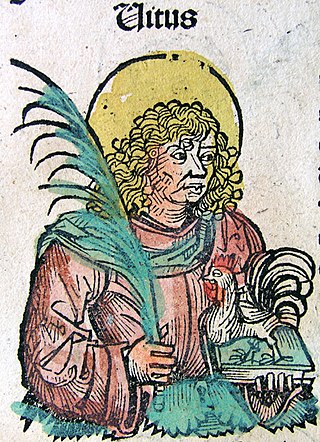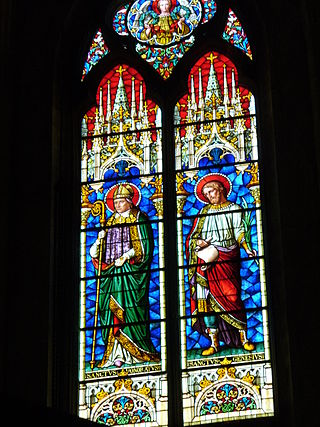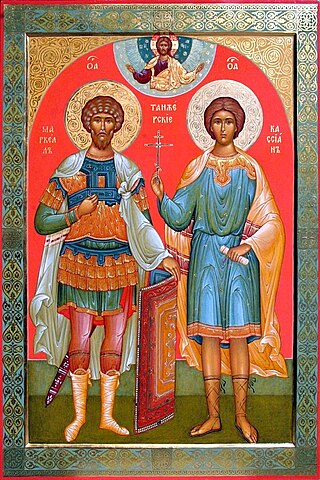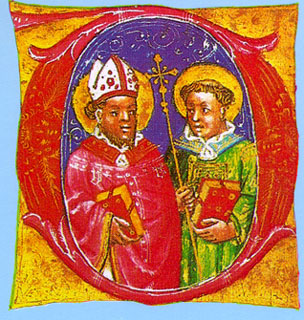
Vitus, whose name is sometimes rendered Guy or Guido, was a Christian martyr from Sicily. His surviving hagiography is pure legend. The dates of his actual life are unknown. He has for long been tied to the Sicilian martyrs Modestus and Crescentia but in the earliest sources it is clear that these were originally different traditions that later became combined. The figures of Modestus and Crescentia are probably fictitious.

Denis of France was a 3rd-century Christian martyr and saint. According to his hagiographies, he was bishop of Paris in the third century and, together with his companions Rusticus and Eleutherius, was martyred for his faith by decapitation. Some accounts placed this during Domitian's persecution and incorrectly identified St Denis of Paris with the Areopagite who was converted by Paul the Apostle and who served as the first bishop of Athens. Assuming Denis's historicity, it is now considered more likely that he suffered under the persecution of the emperor Decius shortly after AD 250.

Saint Eustace is revered as a Christian martyr. According to legend, he was martyred in AD 118, at the command of emperor Hadrian. Eustace was a pagan Roman general, who converted to Christianity after he had a vision of the cross while hunting. He lost all his wealth, was separated from his wife and sons, and went into exile in Egypt. Called back to lead the Roman army by emperor Trajan, Eustace was happily reunited with his family and restored to high social standing, but after the death of Trajan, he and his family were martyred under Hadrian for refusing to sacrifice to pagan Roman gods.

Lecce is a city in southern Italy and former capital of the province of Lecce, with the second-highest population in the Apulia region. It is on the Salentine Peninsula, at the heel of the Italian Peninsula, and is over two thousand years old.

Pancras was a Roman citizen who converted to Christianity and was beheaded for his faith at the age of fourteen, around the year 304. His name is Greek, meaning 'all-powerful'.

Genesius of Arles was a notary martyred under Maximianus in 303 or 308. He is honoured in the Catholic Church as the patron saint of notaries and secretaries, and invoked against chilblains and scurf. His feast day is celebrated on August 25.

Constantius of Perugia is one of the patron saints of Perugia, Italy.

Saint Marcellus of Tangier or Saint Marcellus the Centurion was a Roman centurion who is today venerated as a martyr-saint in both the Eastern Orthodox and the Catholic Church. His feast day is celebrated on October 30.

Pancras or Pancratius is an Italian saint associated with Taormina and venerated as a Christian martyr. His surviving hagiography is purely legendary. He is, however, recorded in some early martyrologies.

Saint Mammes of Caesarea was a child-martyr of the 3rd century, who was martyred at Caesarea. His parents, Theodotus and Rufina, were also martyred.

Hermagoras of Aquileia is considered the first bishop of Aquileia, northern Italy. Christian tradition states that he was chosen by Mark to serve as the leader of the nascent Christian community in Aquileia, and that he was consecrated bishop by Peter. Hermagoras and his deacon Fortunatus evangelized the area but were eventually arrested by Sebastius, a representative of Nero. They were tortured and beheaded.

Saint Fortunatus of Spoleto was a parish priest near Spoleto in Umbria sometime between the 4th and 5th centuries. He is venerated as a saint within the Catholic Church.
Fortunatus of Casei is venerated as a saint by the Catholic Church. Tradition makes him a member of the Theban Legion, and thus martyred at Agaunum. However, his relics were situated in the catacombs of Pope Callixtus I in Rome until 1746, when Cardinal Guadagni, Roman vicar to Benedict XIV, re-exhumed and displayed Fortunatus’ relics in the collegiate church of Santa Maria in Via Lata in Rome. It is unclear how the relics of Fortunatus reached Rome from the saint's supposed place of death in the Swiss Alps.

Chiaffredo is venerated as the patron saint of Saluzzo, Italy. Tradition considers him a member of the Theban Legion, but instead of being martyred with this legion at Agaunum, he escaped to Piedmont and was martyred there.

Saint Antoninus of Pamiers was an early Christian missionary and martyr, called the "Apostle of the Rouergue". His life is dated to the first, second, fourth, and fifth century by various sources since he is often confused with various other venerated Antonini. Today he is revered as the patron saint of Pamiers, Palencia, and Medina del Campo. His historicity and exact identity are in doubt.

Saint Justus of Trieste is a saint venerated in the Eastern Orthodox Church and Roman Catholic Church.

October 13 - Eastern Orthodox liturgical calendar - October 15

Saint Venera is venerated as a Christian martyr of the 2nd century. Little is known of this saint. The date of her death is traditionally given as July 26, 143 AD.

Ostuni Cathedral is a Roman Catholic cathedral in Ostuni, province of Brindisi, region of Apulia, Italy. The dedication is to the Assumption of the Virgin Mary. Formerly the episcopal seat of the Diocese of Ostuni, it has been since 1986 a co-cathedral of the Archdiocese of Brindisi-Ostuni.

Saint Irene of Lecce, also called Erina, is a pre-congregation saint, said to have lived sometime during the 3rd century. She is celebrated mostly in the Eastern Orthodox Church and the Coptic Orthodox Church.



















